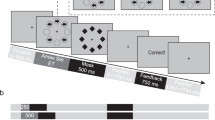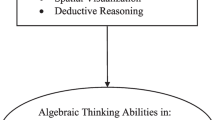Abstract
Abstract thinking is generally highly correlated with problem-solving ability which is predictive of better adaptive functioning. Measures of conceptual reasoning, an ecologically-valid laboratory measure of problem-solving, and a report measure of adaptive functioning in the natural environment, were administered to children and adults with and without autism. The individuals with autism had weaker conceptual reasoning ability than individuals with typical development of similar age and cognitive ability. For the autism group, their flexible thinking scores were significantly correlated with laboratory measures of strategy formation and rule shifting and with reported overall adaptive behavior but not socialization scores. Therefore, in autism, flexibility of thought is potentially more important for adaptive functioning in the natural environment than conceptual reasoning or problem-solving.
Similar content being viewed by others
References
Adams, W. V., & Sheslow, B. V. (1983). A developmental perspective of adolescence. In E. Schopler & G. B. Mesibov (Eds.), Autism in adolescents and adults (pp. 11–36). New York, NY: Plenum Press.
American Psychiatric Association (2000). Diagnostic and statistical manual of mental disorders (4th ed., rev. ed.). Washington, D.C.: Author.
Baez, S., Rattazzi, A., Gonzalez-Gadea, M. L., Torralva, T., Vigliecca, N. S., Decety, J., et al. (2012). Integrating intention and context: Assessing social cognition in adults with Asperger syndrome. Frontiers in Human Neuroscience, 6(302), 1–21.
Benjamini, Y., & Hochberg, Y. (1995). Controlling the false discovery rate: A practical and powerful approach to multiple testing. Journal of the Royal Statistical Society Series B (Methodological), 57, 289–300.
Bogte, H., Flamma, B., van der Meere, J., & van Engeland, H. (2007). Cognitive flexibility in adults with high functioning autism. Journal of Clinical and Experimental Neuropsychology, 11, 1–9.
Boltë, S., & Poustka, F. (2002). The relation between general cognitive level and adaptive behavior domains in individuals with autism with and without co-morbid mental retardation. Child Psychiatric and Human Development, 33, 165–172.
Chamberlain, E. (2003). Behavioural assessment of the dysexecutive syndrome (BADS): Test review. Journal of Occupational Psychology, Employment and Disability, 5, 33–37.
Cohen, J. (1988). Statistical power analysis for the behavioral sciences (2nd ed.). Hillside, NJ: Lawrence Erlbaum Associates.
Farley, M. A., McMahon, W. M., Fombonne, E., Jenson, W. R., Miller, J., Gardner, M., et al. (2009). Twenty-year outcome for individuals with autism and average or near-average cognitive abilities. Autism Research, 2, 109–118.
Fenton, G., D’Ardia, C., Valente, D., Del Vecchio, I., Fabrizi, A., & Bernabei, P. (2001). Vineland adaptive behavior profiles in children with autism and moderate to severe developmental delay. Autism, 7, 269–287.
Goldstein, G. (1996). Functional considerations in neuropsychology. In R. J. Shordone & C. J. Long (Eds.), Ecological validity of neuropsychological testing (pp. 75–89). Delray Beach, FL: Gr Press/St Lucie Press.
Goldstein, G., Johnson, C. R., & Minshew, N. J. (2001). Attentional processes in autism. Journal of Autism and Developmental Disorders, 31, 433–440.
Halstead, W. C., & Settlage, P. H. (1943). Grouping behavior of normal persons and persons with lesions of the brain. Archives of Neurology and Psychiatry, 49, 489–506.
Hayashi, M., Kato, M., Igarashi, K., & Kashima, H. (2008). Superior fluid intelligence in children with Asperger’s disorder. Brain and Cognition, 66(3), 306–310.
Heaton, R. K., Chelune, C. J., Talley, J. L., Kay, G. G., & Curtiss, G. (1993). Wisconsin card sorting test manual, revised and expanded. Odessa, FL: Psychological Assessment Resources.
Heaton, R. K., & Drexler, M. (1987). Clinical and neuropsychological findings in schizophrenia and aging. In N. E. Miller & G. D. Cohen (Eds.), Schizophrenia and aging (pp. 145–161). New York, NY: Guilford Press.
Hill, E. L., & Bird, C. M. (2006). Executive processes in Asperger syndrome: Patterns of performance in a multiple case series. Neuropsychologia, 44, 2822–2835.
Hollingshead, A. B. (1957). Two-factor index of social position. New Haven, CT: Yale University, Department of Sociology.
Hooper, H. E. (1983). Hooper visual organization test (VOT). Los Angeles: Western Psychological Services.
Kandalaft, M. R., Didehbani, N., Krawczyk, D. C., Allen, T. T., & Chapman, S. B. (2013). Virtual reality social cognition training for young adults with high-functioning autism. Journal of Autism and Developmental Disorders, 43(1), 34–44.
Kanne, S. M., Gerber, A. J., Quirmbach, L. M., Sparrow, S. S., Cicchetti, D. V., & Saulnier, C. A. (2011). The role of adaptive behavior in autism spectrum disorders: Implications for functional outcome. Journal of Autism and Developmental Disorders, 41, 1007–1018.
Klin, A., Saulnier, C. A., Sparrow, S. S., Cicchetti, D. V., Volkmar, F. R., & Lord, C. (2007). Social and communication abilities and disabilities in higher-functioning individuals with autism spectrum disorders: The Vineland and ADOS. Journal of Autism and Developmental Disorders, 37, 748–759.
Kourkoulou, A., Leekam, S. R., & Findlay, J. M. (2012). Implicit learning of local context in autism spectrum disorder. Journal of Autism and Developmental Disorders, 42(2), 244–256.
Krasny, L., Williams, B. J., Provencal, S., & Ozonoff, S. (2003). Social skills interventions for the autism spectrum: Essential ingredients and a model curriculum. Child and Adolescent Psychiatric Clinics in North America, 12(1), 107–122.
Laine, M., & Butters, N. (1982). A preliminary study of the problem solving strategies of detoxified long-tern alcoholics. Drug and Alcohol Dependence, 10, 235–242.
LeCouteur, A., Rutter, M., Lord, C., Rios, P., Robertson, S., Holdgrafer, M., et al. (1989). Autism diagnostic interview: A standardized investigator-based instrument. Journal of Autism and Developmental Disorders, 19, 363–387.
Liss, M., Harel, B., Fein, D., Allen, D., Dunn, M., Feinstein, C., et al. (2001). Predictors and correlates of adaptive functioning in children with developmental disorders. Journal of Autism and Developmental Disorders, 31, 219–230.
Lord, C., Risi, S., Lambrecht, L., Cook, E. H, Jr, Leventhal, B. L., DiLavore, P. C., et al. (2000). The autism diagnostic observation schedule—generic: A standard measure of social and communication deficits associated with the spectrum of autism. Journal of Autism and Developmental Disorders, 30, 205–223.
Lord, C., Rutter, M., & Goode, S. (1989). Autism diagnostic observation schedule: A standardized investigator-based instrument. Journal of Autism and Developmental Disorders, 19, 185–212.
Lord, C., Rutter, M., & LeCouteur, A. L. (1994). Autism diagnostic interview revised: A revised version of a diagnostic interview for caregivers of individuals with possible pervasive developmental disorders. Journal of Autism and Developmental Disorders, 24, 659–685.
MacAfee, J. (2002). Navigating the social world: A curriculum for individuals with Asperger’s syndrome, high functioning autism and related disorders. Arlington, TX: Future Horizons Inc.
MacLean, J. E., Szatmari, P., Jones, M. B., Bryson, S. E., Mahoney, W. J., Bartolucci, G., et al. (1999). Familial factors influence level of functioning in pervasive developmental disorder. Journal of the American Academy of Child and Adolescent Psychiatry, 38, 746–753.
Mazefsky, C. A., Williams, D. L., & Minshew, N. J. (2008). Variability in adaptive behavior in Autism: Evidence for the importance of family history. Journal of Abnormal Child Psychology, 36, 591–599.
Minshew, N. J., & Goldstein, G. (2001). The pattern of intact and impaired memory functions in autism. Journal of Child Psychology and Psychiatry, 42, 1095–1101.
Minshew, N. J., Goldstein, G., & Siegel, D. J. (1995). Speech and language in high-functioning autistic individuals. Neuropsychology, 9, 255–261.
Minshew, N. J., Goldstein, G., & Siegel, D. J. (1997). Neuropsychologic functioning in autism: Profile of a complex information processing disorder. Journal of the International Neuropsychological Society, 3, 303–316.
Minshew, N., Luna, B., & Sweeney, J. (1999). Oculomotor evidence for neocortical systems but not cerebellar dysfunctions in autism. Neurology, 52, 917–922.
Minshew, N. J., Meyer, J., & Goldstein, G. (2002). Abstract reasoning in autism: A dissociation between concept formation and concept identification. Neuropsychology, 16, 327–334.
Minshew, N. J., Sung, K., Jones, B., & Furman, J. (2004). Underdevelopment of the postural control system in autism. Neurology, 63, 2056–2061.
Newsom, C., & Hovanitz, C. A. (1997). Autistic disorder. In E. J. Mash & L. G. Terdal (Eds.), Assessment of childhood disorders (3rd ed., pp. 408–452). New York, NY: Guilford.
Oswald, D. P., & DiSalvo, C. A. (2003). Adaptive behavior assessment. In T. H. Ollendick & C. S. Schroeder (Eds.), The encyclopedia of pediatric and clinical child psychology. New York: Kluwer Academic/Plenum Publishers.
Palmen, A., Didden, R., & Lang, R. (2012). A systematic review of behavioral intervention research on adaptive skill building in high-functioning young adults with autism spectrum disorder. Research in Autism Spectrum Disorders, 6, 602–617.
Pennington, B. F., & Ozonoff, S. (1996). Executive functions and developmental psychopathology. Journal of Child Psychology and Psychiatry, 37, 51–87.
Peppé, S., McCann, J., Gibbon, F., O’Hare, A., & Rutherford, M. (2007). Receptive and expressive prosodic ability in children with high-functioning autism. Journal of Speech, Language and Hearing Research, 50, 1015–1028.
Rao, P. A., Beidel, D. C., & Murray, M. J. (2008). Social skills interventions for children with Asperger’s syndrome or high-functioning autism: A review and recommendations. Journal of Autism and Developmental Disorders, 38(2), 353–361.
Reitan, R. M., & Wolfson, D. (1993). The Halstead-retain neuropsychological test battery: Theory and clinical interpretation (2nd ed.). Tucson, AZ: Neuropsychology Press.
Rutter, M. (1983). Cognitive deficits in the pathogenesis of autism. Journal of Child Psychology and Psychiatry and Allied Disciplines, 24, 513–531.
Simon, H. (1975). The functional equivalence of problem solving skills. Cognitive Psychology, 7, 268–288.
Solomon, M., Buaminger, N., & Rogers, S. J. (2011). Abstract reasoning and friendship in high functioning preadolescents with autism spectrum disorders. Journal of Autism and Developmental Disorders, 41(1), 32–43.
Soulières, I., Dawson, M., Gernsbacher, M. A., & Mottron, L. (2011). The level and nature of autistic intelligence II: What about Asperger syndrome? PLoS ONE, 6, e25372.
Sparrow, S. S., Balla, D. A., & Cicchetti, D. V. (1984). Vineland adaptive behavior scales. Circle Pines, MN: American Guidance Service.
Thorndike, R. L., Hagen, E. P., & Sattler, J. M. (1986). The stanford-binet intelligence scale (4th ed.). Chicago: Riverside Publishing.
Williams, D. L., Goldstein, G., & Minshew, N. J. (2005). Impaired memory for faces and social scenes in autism: Clinical implications of the memory disorder. Archives of Clinical Neuropsychology, 20, 1–15.
Williams, D. L., Goldstein, G., & Minshew, N. J. (2006a). Neuropsychologic functioning in children with autism: Further evidence of disordered complex information processing. Child Neuropsychology, 12, 279–298.
Williams, D. L., Goldstein, G., & Minshew, N. J. (2006b). Profile of memory function in children with autism. Neuropsychology, 20, 21–29.
Wilson, B. A., Alderman, N., Burgess, P. W., Emslie, H., & Evans, J. J. (1996). Behavioural assessment dysexecutive syndrome. Bury St. Edmunds, Suffolk, England: Thames Valley Test Company.
Acknowledgments
This research was supported by Grant Sponsor: National Institute of Child Health and Human Development (NICHD), Grant Number: HD35469, a Collaborative Program of Excellence in Autism (CPEA); Grant Sponsor: National Institute on Deafness and other Communication Disorders (NIDCD), Grant Number K23DC006691 to Dr. Williams and by the VISN IV Mental Illness Research, Education and Clinical Center (MIRECC), VA Pittsburgh Healthcare System Pittsburgh PA.
Author information
Authors and Affiliations
Corresponding author
Additional information
The research described here has been approved by the appropriate IRB and full informed consent or assent has been obtained for all subjects.
Rights and permissions
About this article
Cite this article
Williams, D.L., Mazefsky, C.A., Walker, J.D. et al. Associations Between Conceptual Reasoning, Problem Solving, and Adaptive Ability in High-functioning Autism. J Autism Dev Disord 44, 2908–2920 (2014). https://doi.org/10.1007/s10803-014-2190-y
Published:
Issue Date:
DOI: https://doi.org/10.1007/s10803-014-2190-y




